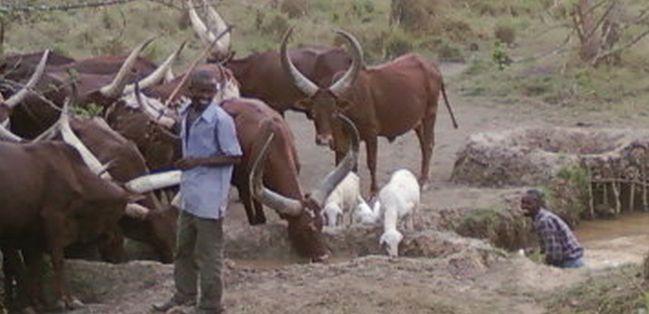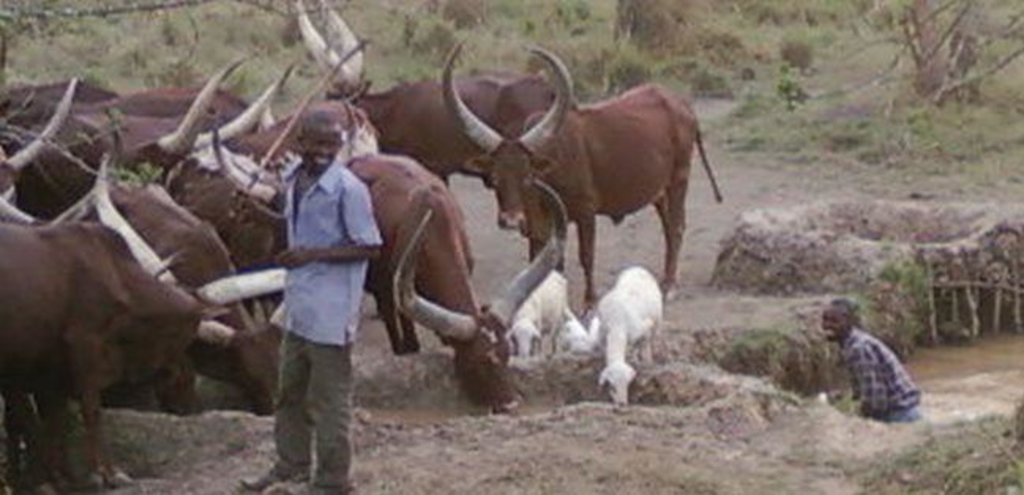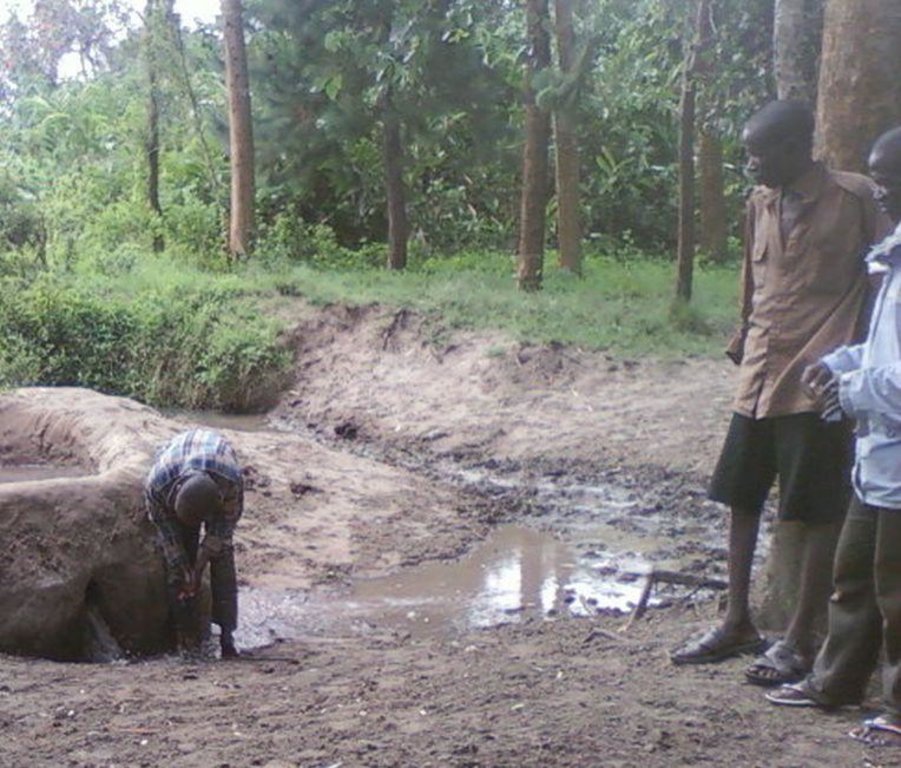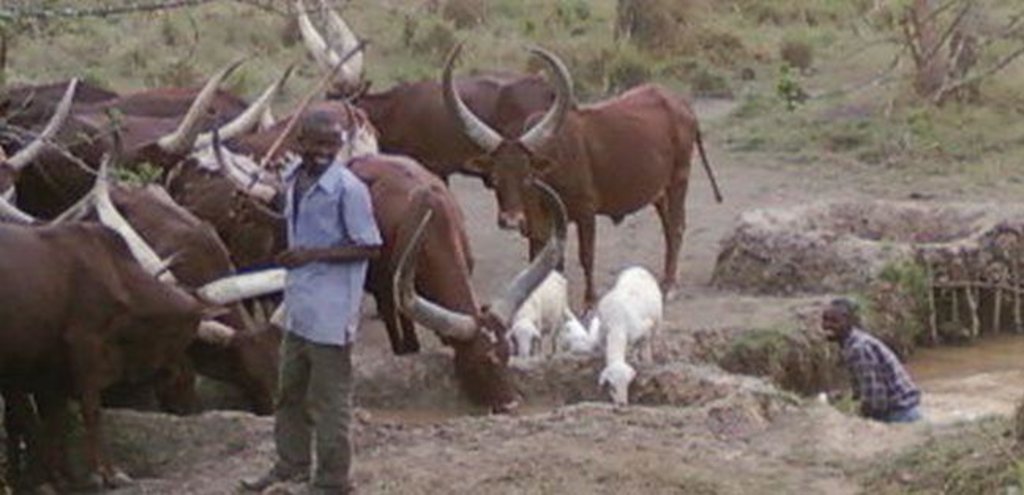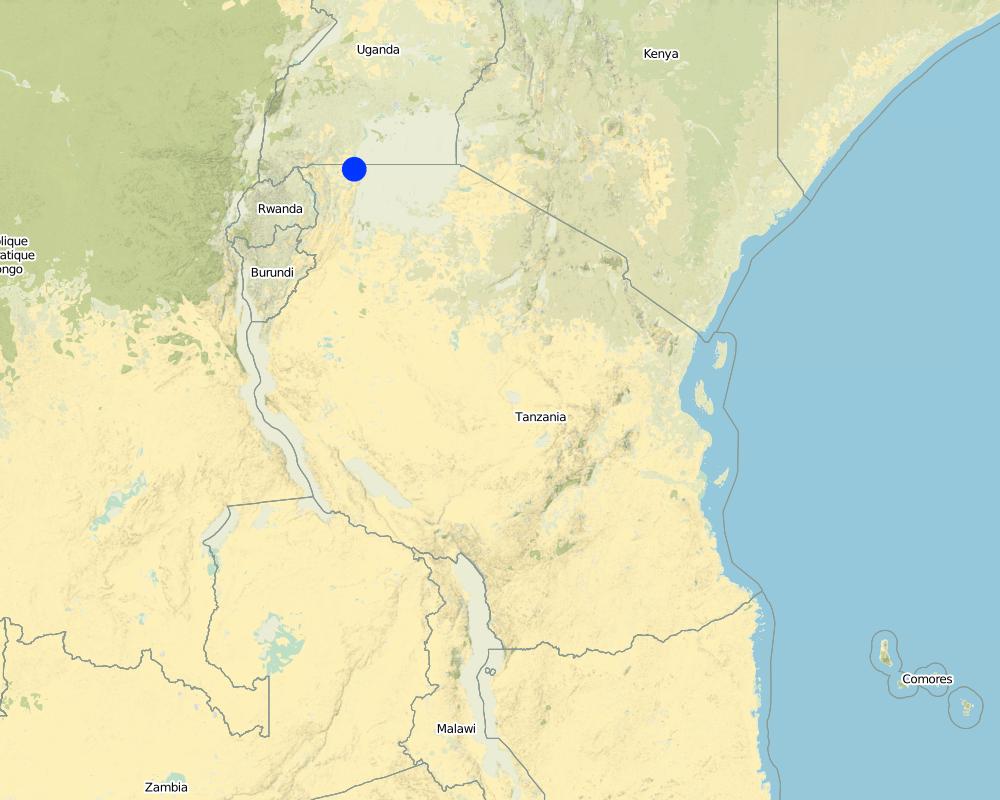Livestock keepers initiative for continued dry season animal drinking water supply [Tanzania, República Unida de]
- Creación:
- Actualización:
- Compilador: ALLAN BUBELWA
- Editor: –
- Revisor: Fabian Ottiger
Emigilile ya abatungi b’ente oyokueshela ente
approaches_2589 - Tanzania, República Unida de
Visualizar secciones
Expandir todo Colapsar todos1. Información general
1.2 Detalles de contacto de las personas de referencia e instituciones involucradas en la evaluación y la documentación del Enfoque
Especialista MST:
Especialista MST:
Especialista MST:
Subira John
Missenyi district council
Tanzania, República Unida de
Especialista MST:
Kagaruki Annagrace
Missenyi district council
Tanzania, República Unida de
Especialista MST:
Kitundu Elizabeth
+255 0732983531,
missenyicouncil@yahoo.com
Missenyi District Council
Box 38 Kyaka Missenyi Kagera
Tanzania, República Unida de
Especialista MST:
Kaihura Fidelis
National Project Manager
Tanzania, República Unida de
Nombre del proyecto que facilitó la documentación/ evaluación del Enfoque (si fuera relevante)
The Transboundary Agro-ecosystem Management Project for the Kagera River Basin (GEF-FAO / Kagera TAMP )Nombre de la(s) institución(es) que facilitaron la documentación/ evaluación del Enfoque si fuera relevante)
Food and Agriculture Organization of the United Nations (FAO) - ItaliaNombre de la(s) institución(es) que facilitaron la documentación/ evaluación del Enfoque si fuera relevante)
Missenyi District Council (Missenyi District Council) - Tanzania, República Unida de1.3 Condiciones referidas al uso de datos documentados mediante WOCAT
¿Cuándo se compilaron los datos (en el campo)?
28/08/2012
El compilador y la/s persona(s) de referencia claves aceptan las condiciones acerca del uso de los datos documentados mediante WOCAT :
Sí
1.4 Referencia/s al/los Cuestionario(s) de Tecnologías MST
2. Descripción del Enfoque MST
2.1 Breve descripción del Enfoque
Livestock keepers groups and local government collaboration for management of livestock watering points.
2.2 Descripción detallada del Enfoque MST
Descripción detallada del Enfoque MST:
Aims / objectives: The main aim of this approach is to improve management of water resources through strengthening collaboration between land owners and livestock keepers for efficient livestock production/management and increased incomes. This approach ensures livestock watering point accessibility during dry seasons. Objective is to reach a compromise between livestock keepers and land owners on terms of conditions for access and use of watering points. As results livestock keepers and land owner can improve their planning activities and minimize conflict between them.
Methods: A self-help livestock keepers group is normally formed. It establishes regular and efficient cooperation among the livestock keepers and negotiations with land owners on water access issues. They make financial contributions to support the established self-help group. Through these contributions construction and maintenance of the ponds and troughs (the livestock watering system) is assured. Construction and maintenance is also done through voluntary work.
This traditional system was developed by elders and spread through learning by doing from the old to the young generation. In passing over knowledge from the elderly to the youths, experience in livestock and water resources management systems is gained.
The approach is also characterized by reverence to the existing village by-laws reinforced by the village government as well as existing customary laws to prevent degradation and pollution of water sources. Extension officers provide technical backstopping on recommended animal health practices that include deworming, routine spraying and vaccination against diseases.
Stages of implementation: Implementation takes place in three stages
1) Livestock keeper group formation: The group size is determined by the number of livestock. A single trough can accommodate not more than 150 cattle which determine the number of livestock keepers to form a group. The group has its informal organizational system with a nominated leader.
2) Contributions and voluntary works: Each livestock keeper makes a payment of about 20 dollars to the land owner as annual user fee. Maintenance is the responsibility of all livestock keepers.
3) Management: Include use of by-laws and provision of advisory services
Role of stakeholders: Land owner: He has the key role of ensuring that the area is used in a sustainable manner. Group members pay land rent to him for area utilization and management.
Livestock keepers: These are key users of the area, voluntarily participate in construction and maintenance of water troughs, pay land rent, manage and control watering of their animals.
Village and Ward administration and elders: Ensuring that village by-laws and customary laws guiding use of fragile ecosystems are adhered to.
Ward and village extension officers: Provide technical advisory to livestock keepers.
District administration and extension staff: Facilitating and enabling community understanding of policy, acts and laws guiding use of fragile ecosystems so that they can make informed management decision.
Other important information: This approach plays significant role in preventing conflict between domestic water users and livestock keepers especially during the dry season.
2.3 Fotos del Enfoque
2.5 País/ región/ lugares donde el Enfoque fue aplicado
País:
Tanzania, República Unida de
Región/ Estado/ Provincia:
TANZANIA
Especifique más el lugar :
MISSENYI
Map
×2.7 Tipo de Enfoque
- tradicional/ local
2.8 Propósitos/ objetivos principales del Enfoque
The Approach focused mainly on SLM with other activities (Construction, managment and utilization)
Minimizing of land dagradation and better water availability to contribute to livelihood improvement.
The SLM Approach addressed the following problems: 1. There was no livestock keepers organization to comprise over use of water resource during the dry season.
2. Water use conflict between livestock keepers and domestic water users
3. Weak administration of bylaws.
2.9 Condiciones que facilitan o impiden la implementación de la/s Tecnología/s aplicadas bajo el Enfoque
normas y valores sociales/ culturales/ religiosos
- impiden
Traditionally livestock keepers keep large herds for prestige.
Treatment through the SLM Approach: Livestock keeper with large herds are advised to reduce number of animals by selling extra animals and use funds for intensifying management and maximizing productivity.
disponibilidad/ acceso a recursos y servicios financieros
- impiden
Livestock keepers are not aware of the services provided by financial institutions and are ignorant of the basic bookkeeping skills.
Treatment through the SLM Approach: Sensitized livestock keepers on utilization of financial institutions and provide training in the basic bookkeeping skills.
entorno institucional
- impiden
Livestock keepers informally organized but not legally recognized; the groups are not registered and have no written constitution.
Treatment through the SLM Approach: Livestock keeper advised to strengthen their groups/organization through registration by relevant authorities and establish a written group constitution.
marco de trabajo legal (tenencia de tierra, derechos de uso de tierra y agua)
- impiden
Ignorance of livestock keepers on the Act, Laws and Rules governing the use of fragile ecosystems.
Treatment through the SLM Approach: Extension workers enabling and facilitating community understanding of policy and acts guiding use of fragile ecosystems.
conocimiento de MST, acceso a apoyo técnico
- impiden
Low knowledge on recommended livestock rearing practises and water borne diseases.
Treatment through the SLM Approach: Training livestock keepers on recommended livestock rearing practices, prevention and controll of water borne diseases as well as water hygine and sanitation.
carga de trabajo, disponibilidad de mano de obra
- impiden
High work load needed in filling of the water troughs
Treatment through the SLM Approach: Livestock keepers advised to use water pumping machines (simple and manually operated machines).
3. Participación y roles de las partes interesadas involucradas
3.1 Partes interesadas involucradas en el Enfoque y sus roles
- usuarios locales de tierras/ comunidades locales
Key implementer and user of the SLM approach, the land owner and the livestock keepers
Traditionally grazing stocks (cattle, sheep and goats) are owned and reared by men and therefore the approach mainly involves men. The roles area largely men specific.The approach also targeted low income livestock owners (casual cattle herds man).
- especialistas MST/consejeros agrícolas
District, ward and village extension officers
- gobierno local
Provision of technical advisory services, policy and act interpretation and reinforcement of village bylaws.
- gobierno nacional (planificadores, autoridades)
Village and Ward elected and employed representatives.
3.2 Involucramiento de los usuarios locales de tierras/ comunidades locales en las distintas fases del Enfoque
| Involucramiento de los usuarios locales de tierras/ comunidades locales | Especifique quién se involucró y describa las actividades | |
|---|---|---|
| iniciación/ motivación | auto-movilización | Livestock keepers /elders: Inheritance and transference of the approach to youth. |
| planificación | auto-movilización | Livestock keepers /elders: Informal planning and improvement through cycles of action and reflection. |
| implementación | auto-movilización | Livestock keepers individuals and groups, village leaders and agricultural advisers: use of the approach, law enforcement and technical advisory services and interpretation of act, law and guidelines protecting fragile ecosystems. |
| monitoreo y evaluación | auto-movilización | Livestock keepers individuals and groups, village leaders and agricultural advisers and SLM specialists: manage effective use of the technology, ensure adherence of Acts, Rules and Regulation and SLM documentation for dissemination and sharing. |
| Research | interactivo | Livestock keepers individuals and groups and agricultural advisers and SLM specialists: identification and documentation of researchable issues. |
3.3 Flujograma (si estuviera disponible)
Descripción:
Livestock keepers initiative for continued dry season animal drinking water supply.
Autor:
Allan Bubelwa (Box 38 Kyaka, Missenyi, Kagera, United Tanzania)
3.4 La toma de decisiones en la selección de Tecnología(s) MST
Especifique quién decidió la selección de las Tecnología/ Tecnologías a implementarse:
- solamente usuarios de tierras (autoiniciativa)
Explique:
A decision to use the technology relies on livestock keepers self-mobilization, own choice induced through inheritance and learning by doing.
Decisions on the method of implementing the SLM Technology were made by by land users* alone (self-initiative / bottom-up). Decision to use the method is partly through spontaneous adoption from elders and improvement through cycles of action and reflection.
4. Apoyo técnico, fortalecimiento institucional y gestión del conocimiento
4.1 Construcción de capacidades / capacitación
¿Se proporcionó la capacitación a usuarios de tierras/ otras partes interesadas?
Sí
Especifique quién fue capacitado:
- usuarios de tierras
- personal de campo/ consejeros
- village and ward leaders
Si fuese relevante, también especifique género, edad, estatus, etnicidad, etc.
both men and women and all ages (youth and elders).
Forma de capacitación:
- en el contexto de trabajo
- reuniones públicas
Forma de capacitación:
- seminar and workshops.
Temas avanzados:
Act and Laws guiding the use of fragile ecosystems, prevention of water borne diseases, recommended livestock keeping methods and water management.
4.2 Servicio de asesoría
¿Los usuarios de tierras tienen acceso a un servicio de asesoría?
Sí
Especifique si servicio proporcionado se realizó:
- en los campos de los usuarios de tierras
Describa/ comentarios:
Name of method used for advisory service: Farmer field school ; Key elements: learning by doing on the job and in the field (Number of knowledge sharing activities: on the job training, field practice), adult learning – livestock self-help groups , livestock management. , indegenous and technical knowledge balanced and combined in a complementary manner.; Technical advisory services largely involved building on and improving the successful experience resulted from the use of indigenous knowledge.
Advisory service is quite adequate to ensure the continuation of land conservation activities; The increase number of extension workers from 1 to 2 and introduction of TAMP project (trans boundary agro-ecosystem management project) in the village will speed up implementation of conservation activities in the village.
4.3 Fortalecimiento institucional (desarrollo institucional)
¿Se establecieron o fortalecieron instituciones mediante el Enfoque?
- no
4.4 Monitoreo y evaluación
¿El monitoreo y la evaluación forman parte del Enfoque?
Sí
Comentarios:
bio-physical aspects were ad hoc monitored by government, land users through observations; indicators: extent of area eroded
bio-physical aspects were ad hoc monitored by government, land users through measurements; indicators: Ponds/troughs and maintenance requirements
technical aspects were ad hoc monitored by land users through observations; indicators: number of livestock keeper trained
technical aspects were ad hoc monitored by land users through measurements; indicators: number of conflicts between land owners and livestock keepers
socio-cultural aspects were ad hoc monitored by land users through observations; indicators: number of water conflict emerged and number resolved
socio-cultural aspects were ad hoc monitored by government, land users through measurements; indicators: livestock production and productivity
economic / production aspects were regular monitored by government through observations; indicators: increase in milk and meat productivity
economic / production aspects were regular monitored by government, land users through measurements; indicators: livestock keepers using the technology
no. of land users involved aspects were regular monitored by government, land users through observations; indicators: number of livestock keepers using the technology
no. of land users involved aspects were regular monitored by government, land users through measurements; indicators: adherence to water protective bylaws
management of Approach aspects were regular monitored by government through observations; indicators: % number of village bylaws used and adhered to
management of Approach aspects were regular monitored by government through measurements; indicators: None
There were few changes in the Approach as a result of monitoring and evaluation: Implementation of group roles and adherence to by-laws e.g. protection of natural vegetation.
There were few changes in the Technology as a result of monitoring and evaluation: decrease in destruction of natural vegetation and reduction of eutrophication at the water source.
4.5 Investigación
¿La investigación formó parte del Enfoque?
Sí
- adaptive SLM trials
Proporcione detalles adicionales e indique quién hizo la investigación:
Adaptive trials through SLM demos by TAMP, ARI MARUKU and community. Farmers select the best bets technologies to apply on their own fields.
Research was carried out on-farm
5. Financiamiento y apoyo material externo
5.1 Presupuesto anual para el componente MST del Enfoque
Si no se conoce el presupuesto anual preciso, indique el rango:
- < 2,000
Comentarios (ej. fuentes principales de financiamiento/ donantes principales):
Approach costs were met by the following donors: local government (district, county, municipality, village etc) (animal related extesion services, policy and law enforcement.): 20.0%; local community / land user(s) (voluntary contribution by livestock keeper groups and land owner ): 80.0%
5.2 Apoyo financiero/material proporcionado a los usuarios de tierras
¿Los usuarios de tierras recibieron financiamiento/ apoyo material para implementar la Tecnología/ Tecnologías? :
No
5.3 Subsidios para insumos específicos (incluyendo mano de obra)
Si la mano de obra de usuarios de tierras fue un insumo sustancial, ¿fue:
- voluntario?
Comentarios:
labour is needed in taking the animals for watering as well as during actual watering of the animals.
5.4 Crédito
¿Se proporcionó crédito bajo el Enfoque para actividades MST?
No
6. Análisis de impacto y comentarios de conclusión
6.1 Impactos del Enfoque
¿El Enfoque ayudó a los usuarios de tierras a implementar y mantener Tecnologías MST?
- No
- Sí, un poco
- Sí, moderadamente
- Sí, mucho
This approach plays significant role in reducing conflict between domestic water users, increased availability of water and conservation of water resources.
¿El Enfoque empoderó a grupos en desventaja social y económica?
- No
- Sí, un poco
- Sí, moderadamente
- Sí, mucho
The approach enables low income-cattle herd man to earn income.
Did other land users / projects adopt the Approach?
- No
- Sí, un poco
- Sí, moderadamente
- Sí, mucho
other livestock group adopted the approach (in dry season).
Did the Approach lead to improved livelihoods / human well-being?
- No
- Sí, un poco
- Sí, moderadamente
- Sí, mucho
Livestock keepers that joined self-help groups improved livestock productivity and increased income
Did the Approach help to alleviate poverty?
- No
- Sí, un poco
- Sí, moderadamente
- Sí, mucho
year round availability of water for animals, increased animal production and productivity and income to livestock keepers and improve rural socio-economic conditions.
6.2 Motivación principal del usuario de la tierra para implementar MST
- producción incrementada
improved animals heath and increased production
- reglas y reglamentos (multas)/ aplicación
rules preventing livestock keepers from watering their animals in domestic water sources
- conciencia medioambiental
developed through various SLM trainings provided by extension officers.
6.3 Sostenibilidad de las actividades del Enfoque
¿Pueden los usuarios de tierras sostener lo que se implementó mediante el Enfoque (sin apoyo externo)?
- incierto
Si respondió no o incierto, especifique y comente:
in the future a support is needed in terms of group management and organizational development, marketing and business planning skills and livestock keepers also need further exposure to SLM concept.
6.4 Fortalezas/ ventajas del Enfoque
| Fuerzas/ ventajas/ oportunidades desde la perspectiva del usuario de la tierra |
|---|
| Is a mechanism for assurance of water availability for animal watering in the dry season. (How to sustain/ enhance this strength: continue with good collaboration with the land owner and livestock keeper solidarity.) |
| Fuerzas/ ventajas/ oportunidades desde la perspectiva del compilador o de otra persona de referencia clave |
|---|
| The training of extension officers, elders etc covered many aspects of sustainable livestock production and natural water resources protection (How to sustain/ enhance this strength: Activities presented during the training should be put into practice and spread among other livestock keepers ) |
| Involvement of the district administration, wards, elders in the approaches implementation (How to sustain/ enhance this strength: insist on active involvement ) |
| Strong commitment of livestock keepers to improve livestock production and their livelihood (How to sustain/ enhance this strength: Awareness raising ) |
| Reduced conflict between water for domestic use and for watering animals (How to sustain/ enhance this strength: strengthen use of the approach and bylaws guiding it ) |
| Reduced cost and largely relies on self mobilization and voluntarism of the livestock keepers. (How to sustain/ enhance this strength: Group management and organizational development to strengthen cohesiveness.) |
| Is dynamic, flexible and accommodate outside advisory and technical support and therefore opens opportunities for future improvement. (How to sustain/ enhance this strength: Needs assessment and provision of appropriate advisory and technical support. ) |
6.5 Debilidades/ desventajas del Enfoque y formas de sobreponerse a ellos
| Debilidades/ desventajas/ riesgos desde la perspectiva del usuario de la tierra | ¿Cómo sobreponerse a ellas? |
|---|---|
| low know how | broadern know how |
| Debilidades/ desventajas/ riesgos desde la perspectiva del compilador o de otra persona de referencia clave | ¿Cómo sobreponerse a ellas? |
|---|---|
| The approach is largely informal in terms of livestock keepers organization. There is no written constitution and the groups are not registration. | improvement in terms of formulation of group constitution, opening of bank account and group registration. |
| Narrow focus largely relies solely on indigenous knowledge base . | broaden horizon of understanding by combining with technical knowledge base. |
| Lack of promotion materials to involve other livestock keepers | increase number of promotion materials |
| Rural poverty not reduced significantly | more activities that can lead to reduction of rural poverty required |
7. Referencias y vínculos
7.1 Métodos/ fuentes de información
- visitas de campo, encuestas de campo
- entrevistas con usuarios de tierras
7.2 Referencias a publicaciones disponibles
Título, autor, año, ISBN:
Kagera TAMP project (pdfFinal Report 2013)
¿Dónde se halla disponible? ¿Costo?
http://www.fao.org/fileadmin/user_upload/oed/docs/GCPRAF424GFF_2013_ER.pdf
Vínculos y módulos
Expandir todo Colapsar todosVínculos
No hay vínculos
Módulos
No se hallaron módulos


